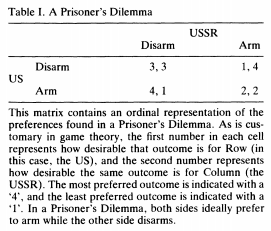The Prisoner’s Dilemma can be explored throughout many historical conflicts. The concept can apply to a large range of scenarios, from small personal decisions to massive world wars.
A prime example of the Prisoner’s Dilemma can be seen during the Cold War between the United States and the Soviet Union. The Cold War was a nuclear arms race between the two opposing factions. Each country had two options: to arm or disarm their nuclear weapons. The possible outcomes of these choices between the United States and the Soviet Union is displayed by the following table:

It is easy to observe that it is a strictly dominant strategy for both parties to arm their nuclear weapons, because it would result in the best outcome for both choices of the opposing party. This is intuitive, because if, for example, if the United States arms their nuclear weapons, then it would be in the Soviet Union’s best interests to match their opponent’s military strength and also arm their weapons, in order to avoid annihilation and gain the opportunity to counterattack. In the other scenario, where the United States disarms their weapons, then the Soviet Union would be inclined to arm their weapons for military superiority. In both cases, arming is the better choice. The same mirrored argument applies to the United States reacting to the Soviet Union. Naturally, both countries chose to arm their weapons, and this large-scale application of the Prisoner’s Dilemma became known as the Cold War.

